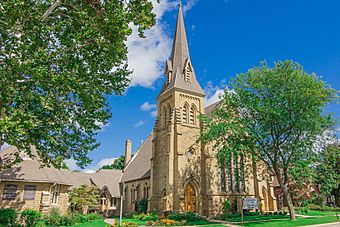Marshall Historic District facts for kids
|
Marshall Michigan Historic Landmark District
|
|

Trinity Episcopal Church
|
|
| Location | Roughly bounded by Plum St., East Dr., Forest St. and Hanover St., Marshall, Michigan |
|---|---|
| Area | 325 acres (132 ha) |
| Architectural style | Mid 19th Century Revival, Late Victorian, Late 19th And 20th Century Revivals |
| NRHP reference No. | 91002053 |
Quick facts for kids Significant dates |
|
| Added to NRHP | July 17, 1991 |
| Designated NHLD | July 17, 1991 |
The Marshall Historic District is a special area in Marshall, Michigan. It's known as a National Historic Landmark District. This means it's a very important place in American history. The district includes many old homes, shops, and public buildings. It's famous because its street plan, buildings, and public areas are very well-preserved. They look much like they did long ago. This makes it one of the largest and best-kept historic areas in the whole country. It was officially named a National Historic Landmark in 1991.
Contents
What Makes Marshall's Historic District Special?
The Marshall Historic District covers about 325 acres. That's like 246 football fields! Inside this area, there are over 750 buildings that are important to history. The district is generally found between Forest Street to the north, Plum Street to the west, Hanover Street to the south, and East Drive to the east. This large area includes the main parts of the city where people lived, worked, and gathered.
How Marshall First Started
Marshall was founded in 1831 by a man named Sidney Ketchum. He bought land here because he thought it would become the capital city of Michigan. He picked this spot because it was next to the Kalamazoo River. It was also close to the main road between Detroit and Chicago.
Over the next ten years, many educated people moved to Marshall. They came from the northeastern United States. These new settlers brought ideas about how to plan a town and build houses. They laid out the city in a neat, straight grid pattern. The first buildings were often in the Greek Revival style. Some of these buildings were very grand and fancy.
Changes and Growth in Marshall
For a while, Marshall grew quickly because people hoped it would be the state capital. But in 1847, Lansing was chosen instead. Even so, Marshall kept growing thanks to new industries and the Michigan Central Railroad. The railroad built its main rail yard here.
Marshall stayed rich and busy until the 1870s. That's when the Michigan Central Railroad closed its big rail yard. Even after that, new buildings were still being built. These new buildings often used popular styles like Italianate and Gothic Revival.
In the early 1900s, Marshall grew more slowly. But the new buildings were still very well-made. They often used Colonial and Classical Revival styles. Because of all this growth, Marshall now has a wonderful collection of buildings. They show many different styles from the 1800s and early 1900s. You can see homes, shops, public buildings, and churches.
Famous Buildings to See
The Marshall Historic District has several very famous buildings.
- The Honolulu House is a unique building. It's built in the Italianate style but has a Hawaiian feel to it.
- The National House is an old inn. It was built in 1835 in the Greek Revival style.
- Wagner's Block is a large and impressive building. It's a commercial block on West Michigan Avenue. It's built in the Second Empire style.



